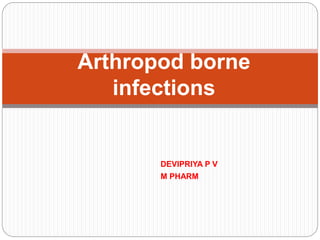
Arthropod borne infections
- 1. DEVIPRIYA P V M PHARM Arthropod borne infections
- 2. CONTENTS Plague Malaria Filariases
- 3. PLAGUE Causative agent: Yersinia Pseudotuberculous Pestis (a gram negative, non- motile, cocco bacillus). Vector: The vector of plague is rat flea Reservoir of infection: Wild rodents Sources of infection are infected rodents, fleas and cases of pneumonic plague (severe lung infection caused by the bacterium Yersinia pestis). Mode of transmission: The Y pestis is transmitted between rodents by fleas . After the death of rat, affected flea leave the rat & bite a man. The infection spread from man to man by droplets.
- 4. Prevention and control: Control can be done by early diagnosis, notification, isolation , disinfection of patient’s sputum and treatment. In adults tetracycline 500 mg q.i.d orally is the drug of choice. Cotrimoxazole is given for children. In several cases , streptomycin is given intramuscularly in the dose of 30 mg/kg body weight per day in two divided doses for 10 days in addition to either of the drugs, Control of fleas can be done by their destruction, by spraying DDT & BHC. Control is done by mass destruction, improvement of housing. Vaccination is a valuable prevention Plague vaccine (formalin killed plague bacilli) is given subcutaneously in two doses of 0.5 and 1.0 ml at 1 to 2 weeks interval. Booster dose is given for every 6 months for those who are at
- 5. MALARIA A group of infection caused by infection with specific sporozoan parasites of genus plasmodium and transmitted to man by infected female Anopheles mosquito. Characterized by episodes of chills and fever with periods of latency(delay), enlargement of spleen and secondary anaemia. Stages of malaria: (A)Cold stage (B)Hot stage (C)Sweating stage. Cold stage : Sudden onset of fever with rigor and chills. This stage lasts between 15 minutes to one hour Hot stage: Headache & burning hot & the casts off clothes This stage lasts from 2 to 6 hours.
- 6. Sweating stage: Profuse sweating. This stage lasts from 2 to 4 hours. Febrile paroxysms occurs repeatedly after a period of 2 to 3 days depending on the type of the malarial parasite. Causative agent: Caused by 4 species of malaria parasite. 1. Plasmodium vivax (responsible for 70% cases in India), 2. Plasmodium falciparum, 3. Plasmodium malarae, 4. Plasmodium ovole The malarial parasite undergoes two cycles of development- asexual cycle in man and sexual cycle in mosquito
- 7. Mode of transmission: (a)Vector transmission: Transmitted by the bite of female Anopheles mosquitoes (b)Direct transmission: Transmitted by infected needles, blood transfusions etc (c)Congenital infection: Occur in new born from infected mother. Incubation period: The time between mosquito bite and the appearance of fever is more than 10 days ranging from 12 to 40 days
- 8. Prevention and control: WHO expert Committee on Malaria (1979) Measures to be taken by the individual: Prevention of man / vector contact by using repellents, protective clothing , bed nets etc. Destruction of adult mosquitoes by domestic sprays. Destruction of mosquito larvae by peridomestic sanitation, intermittent drying of water containers. Source reduction of mosquitoes by filling, small scale drainage and other forms of water management. Measures against malaria parasite include chemoprophylaxis and chemotherapy Measures to be taken by the community. Prevention of man / vector contact- site selection and screening of houses. Destruction of adult mosquitoes- spraying insecticides. Destruction of mosquito larvae- using larvicides
- 9. Source reduction- prevention of man made malaria, environmental sanitation, water management , drainage schemes. Measures against malaria parasite- presumptive treatment, radical treatment, mass drug administration. Treatment of malaria: Presumptive treatment should be given to all fever cases which are assumed to be malaria. For this, choloroquine 250 mg is given, collect the blood simultaneously for microscopic examination. If the slide is positive , then the treatment consists of 1st day: choloroquine 600 mg + Primaquine 15 mg Next 4 days: Primaquine is given in a dose of 15 mg per day Antimalarial vaccine: Clinical trials are in process to develop malaria vaccine
- 10. FILARIASES The group of diseases caused by certain nematodes of the family Filariodea Transmitted to man by certain blood sucking arthropods. The disease can be lymphatic filariasis or non- lymphatic filariasis Lymphatic filariasis: Caused by W. Bancrofti, B. Malayi, B. Timori. Transmitted by the bite of infected mosquitoes. Adult worm live in lymphatic vessels but their offspring (microfilaries) circulates in the peripheral blood and are available to infect the mosquito.
- 11. Causative agent: In India, Lymphatic filariasis is caused by W. Bancrofti, B. Malayi. The infection is transmitted to man by the bite of infected mosquitoes. Man is the definitive host and mosquito is the intermediate host Control of filariasis: Control is based on chemotherapy and vector control. Chemotherapy : Drug used is Diethylcarbamazine(DEC) (Hetrazan tablets) For W. Bancrofti infection the dose of DEC is 6 mg per kg body weight per daily orally after meal in divided doses for 12 days. For B. Malayi DEC is given in a dose ranging from 3
- 12. Vector control: Elimination of breeding places of mosquitoes by adequate sanitation and underground waste water disposal system Destruction of adult mosquitoes by using insecticides Putting larvicidal oil on collected waste or using organophosphorous larvicides